Cyber Security Report: Analyzing Hybrid Feature Selection for Phishing
VerifiedAdded on 2023/06/15
|6
|914
|387
Report
AI Summary
This report provides an analysis of phishing email detection methods, focusing on a hybrid approach that combines behavior-based and content-based techniques. The paper examines how attackers use spoofed emails to direct users to malicious websites, compromising their credentials and personal details. It evaluates the limitations of individual content-based and behavior-based approaches and highlights the potential of a hybrid model to mitigate phishing attacks. The report also discusses the use of tools like Mbox2xml and algorithms like Bayes Net and Simulated Annealing Search for detecting and analyzing attacker behavior. While the original paper primarily focuses on theoretical analysis and lacks practical experimentation, this report summarizes its findings and suggests potential future research directions. Desklib offers more solved assignments for students.
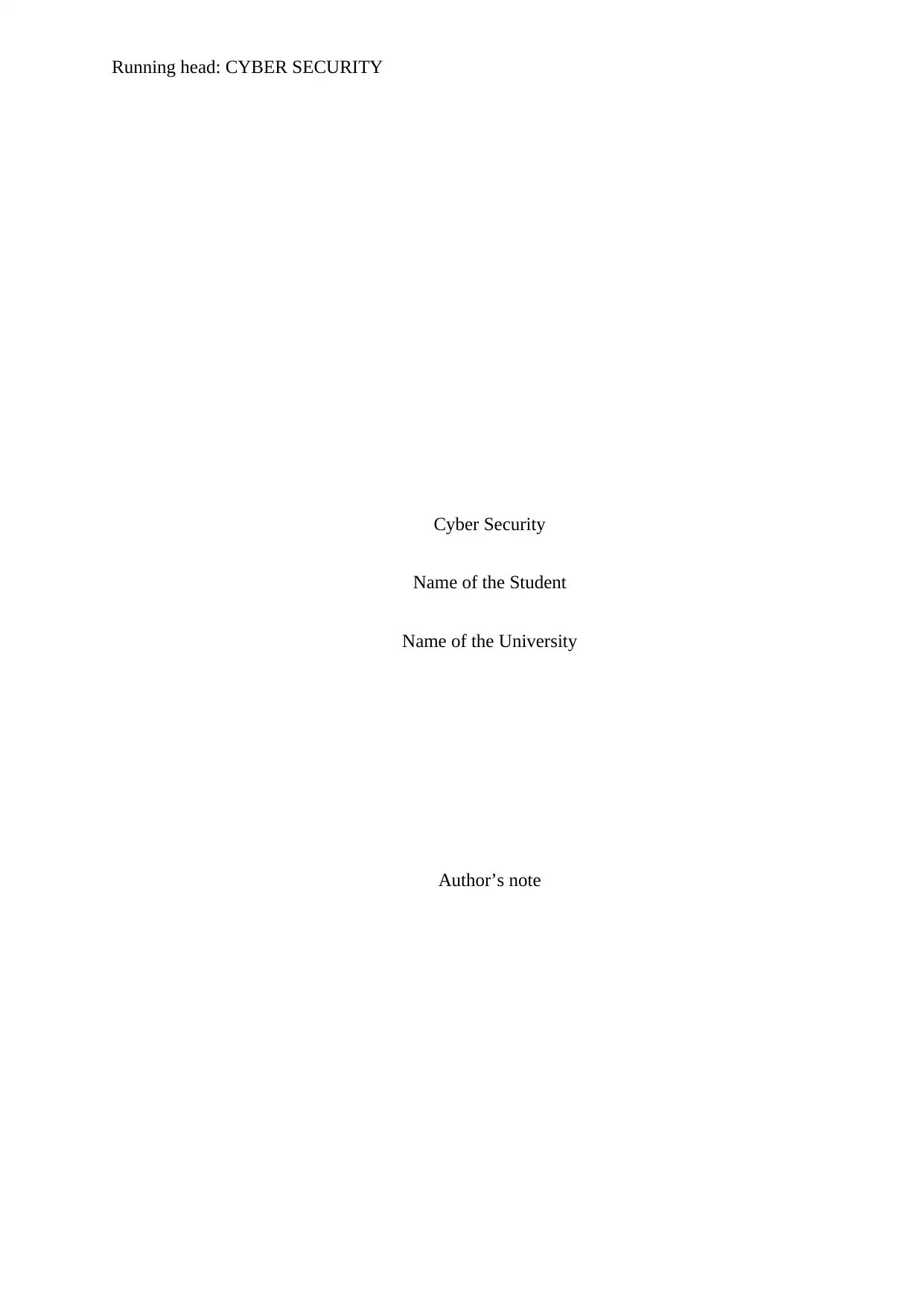
Running head: CYBER SECURITY
Cyber Security
Name of the Student
Name of the University
Author’s note
Cyber Security
Name of the Student
Name of the University
Author’s note
Paraphrase This Document
Need a fresh take? Get an instant paraphrase of this document with our AI Paraphraser
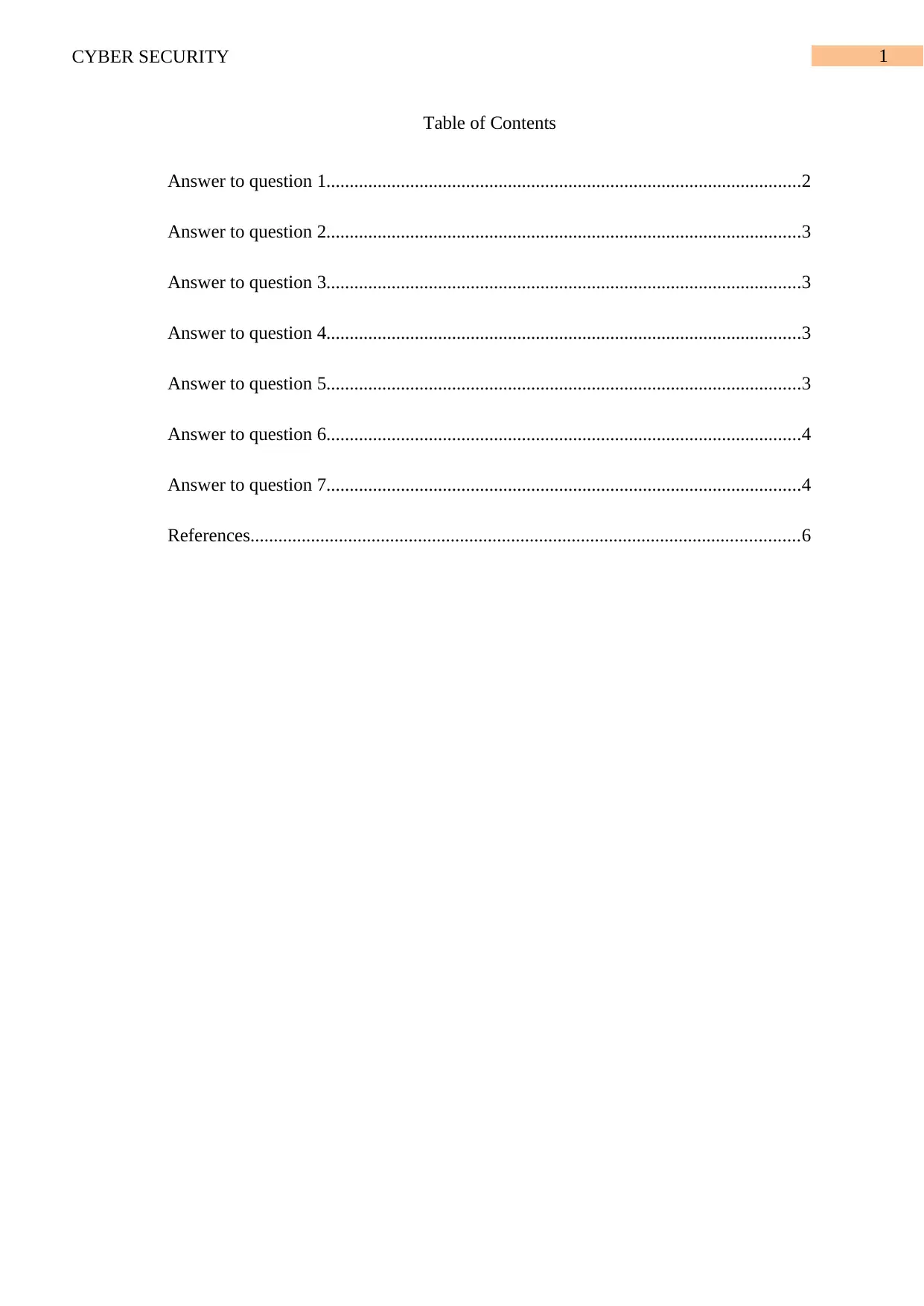
1CYBER SECURITY
Table of Contents
Answer to question 1......................................................................................................2
Answer to question 2......................................................................................................3
Answer to question 3......................................................................................................3
Answer to question 4......................................................................................................3
Answer to question 5......................................................................................................3
Answer to question 6......................................................................................................4
Answer to question 7......................................................................................................4
References......................................................................................................................6
Table of Contents
Answer to question 1......................................................................................................2
Answer to question 2......................................................................................................3
Answer to question 3......................................................................................................3
Answer to question 4......................................................................................................3
Answer to question 5......................................................................................................3
Answer to question 6......................................................................................................4
Answer to question 7......................................................................................................4
References......................................................................................................................6
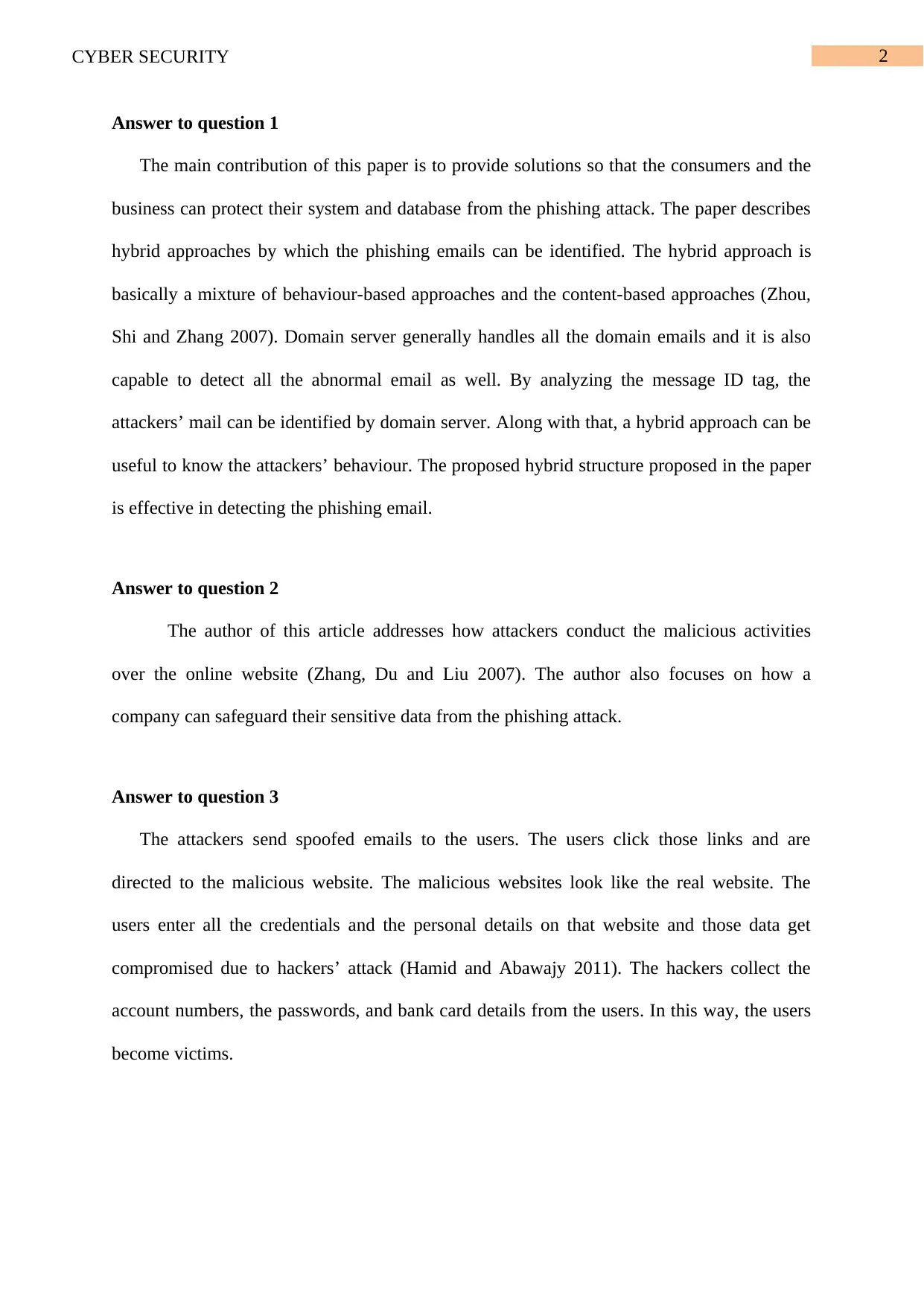
2CYBER SECURITY
Answer to question 1
The main contribution of this paper is to provide solutions so that the consumers and the
business can protect their system and database from the phishing attack. The paper describes
hybrid approaches by which the phishing emails can be identified. The hybrid approach is
basically a mixture of behaviour-based approaches and the content-based approaches (Zhou,
Shi and Zhang 2007). Domain server generally handles all the domain emails and it is also
capable to detect all the abnormal email as well. By analyzing the message ID tag, the
attackers’ mail can be identified by domain server. Along with that, a hybrid approach can be
useful to know the attackers’ behaviour. The proposed hybrid structure proposed in the paper
is effective in detecting the phishing email.
Answer to question 2
The author of this article addresses how attackers conduct the malicious activities
over the online website (Zhang, Du and Liu 2007). The author also focuses on how a
company can safeguard their sensitive data from the phishing attack.
Answer to question 3
The attackers send spoofed emails to the users. The users click those links and are
directed to the malicious website. The malicious websites look like the real website. The
users enter all the credentials and the personal details on that website and those data get
compromised due to hackers’ attack (Hamid and Abawajy 2011). The hackers collect the
account numbers, the passwords, and bank card details from the users. In this way, the users
become victims.
Answer to question 1
The main contribution of this paper is to provide solutions so that the consumers and the
business can protect their system and database from the phishing attack. The paper describes
hybrid approaches by which the phishing emails can be identified. The hybrid approach is
basically a mixture of behaviour-based approaches and the content-based approaches (Zhou,
Shi and Zhang 2007). Domain server generally handles all the domain emails and it is also
capable to detect all the abnormal email as well. By analyzing the message ID tag, the
attackers’ mail can be identified by domain server. Along with that, a hybrid approach can be
useful to know the attackers’ behaviour. The proposed hybrid structure proposed in the paper
is effective in detecting the phishing email.
Answer to question 2
The author of this article addresses how attackers conduct the malicious activities
over the online website (Zhang, Du and Liu 2007). The author also focuses on how a
company can safeguard their sensitive data from the phishing attack.
Answer to question 3
The attackers send spoofed emails to the users. The users click those links and are
directed to the malicious website. The malicious websites look like the real website. The
users enter all the credentials and the personal details on that website and those data get
compromised due to hackers’ attack (Hamid and Abawajy 2011). The hackers collect the
account numbers, the passwords, and bank card details from the users. In this way, the users
become victims.
⊘ This is a preview!⊘
Do you want full access?
Subscribe today to unlock all pages.

Trusted by 1+ million students worldwide
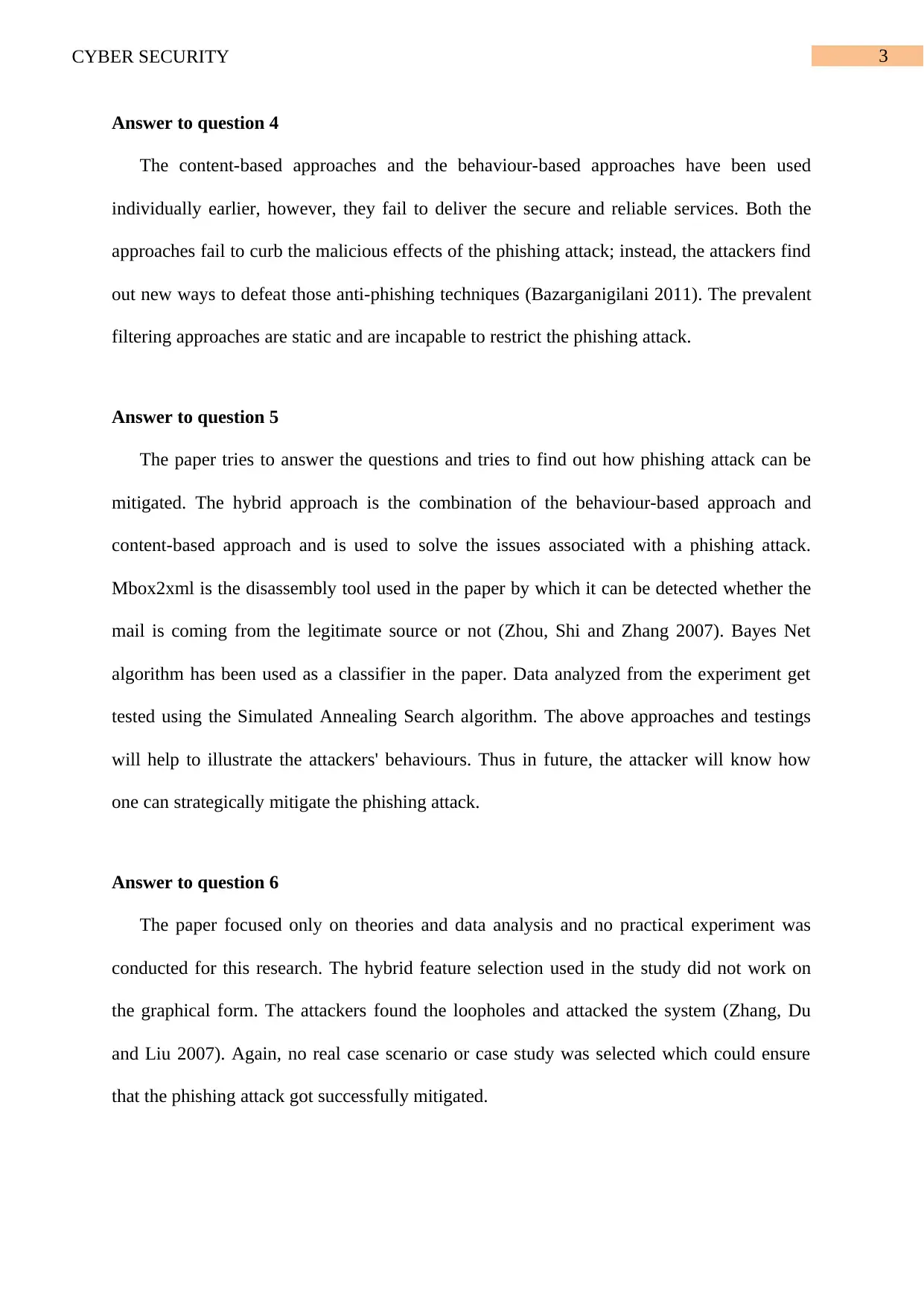
3CYBER SECURITY
Answer to question 4
The content-based approaches and the behaviour-based approaches have been used
individually earlier, however, they fail to deliver the secure and reliable services. Both the
approaches fail to curb the malicious effects of the phishing attack; instead, the attackers find
out new ways to defeat those anti-phishing techniques (Bazarganigilani 2011). The prevalent
filtering approaches are static and are incapable to restrict the phishing attack.
Answer to question 5
The paper tries to answer the questions and tries to find out how phishing attack can be
mitigated. The hybrid approach is the combination of the behaviour-based approach and
content-based approach and is used to solve the issues associated with a phishing attack.
Mbox2xml is the disassembly tool used in the paper by which it can be detected whether the
mail is coming from the legitimate source or not (Zhou, Shi and Zhang 2007). Bayes Net
algorithm has been used as a classifier in the paper. Data analyzed from the experiment get
tested using the Simulated Annealing Search algorithm. The above approaches and testings
will help to illustrate the attackers' behaviours. Thus in future, the attacker will know how
one can strategically mitigate the phishing attack.
Answer to question 6
The paper focused only on theories and data analysis and no practical experiment was
conducted for this research. The hybrid feature selection used in the study did not work on
the graphical form. The attackers found the loopholes and attacked the system (Zhang, Du
and Liu 2007). Again, no real case scenario or case study was selected which could ensure
that the phishing attack got successfully mitigated.
Answer to question 4
The content-based approaches and the behaviour-based approaches have been used
individually earlier, however, they fail to deliver the secure and reliable services. Both the
approaches fail to curb the malicious effects of the phishing attack; instead, the attackers find
out new ways to defeat those anti-phishing techniques (Bazarganigilani 2011). The prevalent
filtering approaches are static and are incapable to restrict the phishing attack.
Answer to question 5
The paper tries to answer the questions and tries to find out how phishing attack can be
mitigated. The hybrid approach is the combination of the behaviour-based approach and
content-based approach and is used to solve the issues associated with a phishing attack.
Mbox2xml is the disassembly tool used in the paper by which it can be detected whether the
mail is coming from the legitimate source or not (Zhou, Shi and Zhang 2007). Bayes Net
algorithm has been used as a classifier in the paper. Data analyzed from the experiment get
tested using the Simulated Annealing Search algorithm. The above approaches and testings
will help to illustrate the attackers' behaviours. Thus in future, the attacker will know how
one can strategically mitigate the phishing attack.
Answer to question 6
The paper focused only on theories and data analysis and no practical experiment was
conducted for this research. The hybrid feature selection used in the study did not work on
the graphical form. The attackers found the loopholes and attacked the system (Zhang, Du
and Liu 2007). Again, no real case scenario or case study was selected which could ensure
that the phishing attack got successfully mitigated.
Paraphrase This Document
Need a fresh take? Get an instant paraphrase of this document with our AI Paraphraser
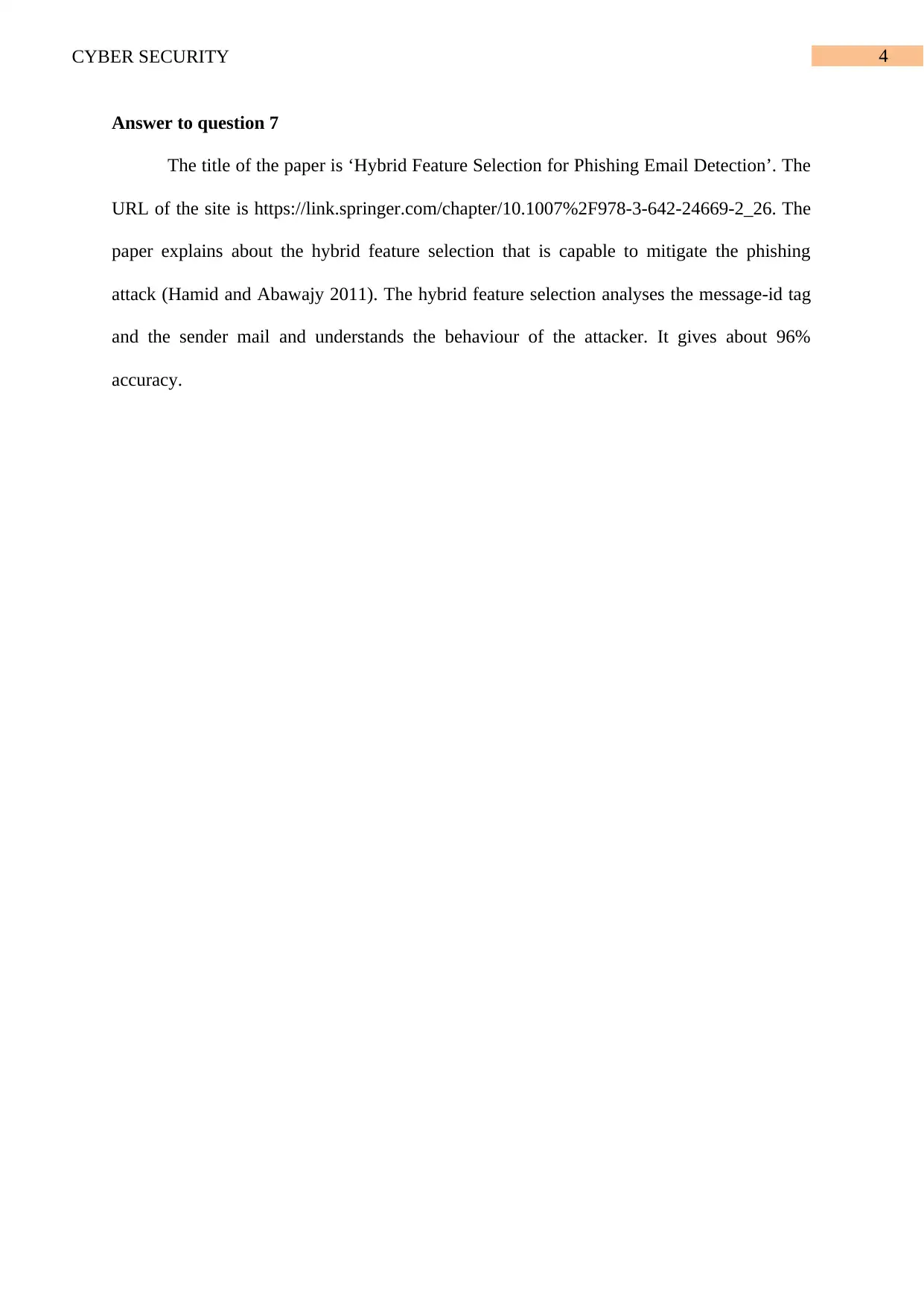
4CYBER SECURITY
Answer to question 7
The title of the paper is ‘Hybrid Feature Selection for Phishing Email Detection’. The
URL of the site is https://link.springer.com/chapter/10.1007%2F978-3-642-24669-2_26. The
paper explains about the hybrid feature selection that is capable to mitigate the phishing
attack (Hamid and Abawajy 2011). The hybrid feature selection analyses the message-id tag
and the sender mail and understands the behaviour of the attacker. It gives about 96%
accuracy.
Answer to question 7
The title of the paper is ‘Hybrid Feature Selection for Phishing Email Detection’. The
URL of the site is https://link.springer.com/chapter/10.1007%2F978-3-642-24669-2_26. The
paper explains about the hybrid feature selection that is capable to mitigate the phishing
attack (Hamid and Abawajy 2011). The hybrid feature selection analyses the message-id tag
and the sender mail and understands the behaviour of the attacker. It gives about 96%
accuracy.
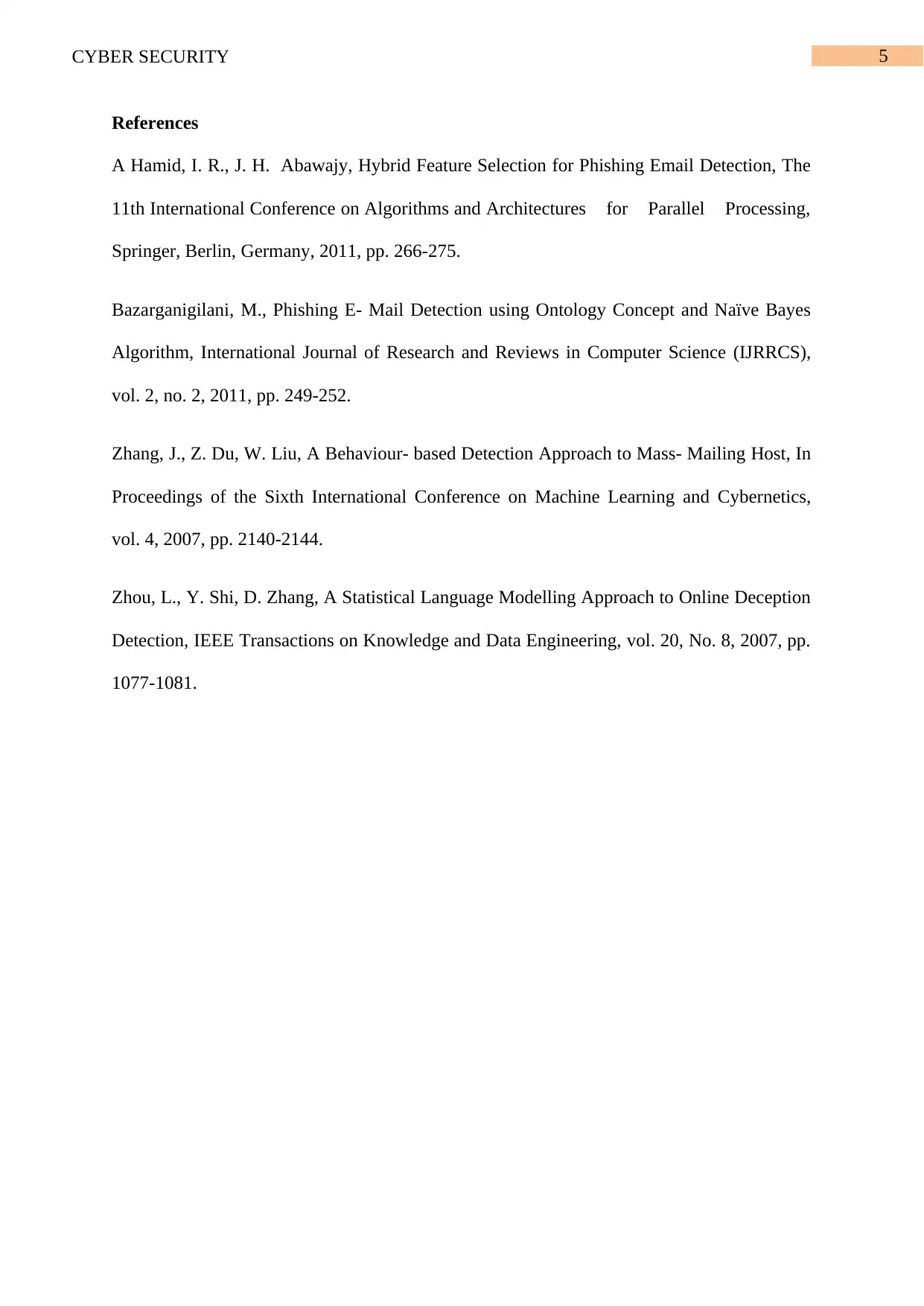
5CYBER SECURITY
References
A Hamid, I. R., J. H. Abawajy, Hybrid Feature Selection for Phishing Email Detection, The
11th International Conference on Algorithms and Architectures for Parallel Processing,
Springer, Berlin, Germany, 2011, pp. 266-275.
Bazarganigilani, M., Phishing E- Mail Detection using Ontology Concept and Naïve Bayes
Algorithm, International Journal of Research and Reviews in Computer Science (IJRRCS),
vol. 2, no. 2, 2011, pp. 249-252.
Zhang, J., Z. Du, W. Liu, A Behaviour- based Detection Approach to Mass- Mailing Host, In
Proceedings of the Sixth International Conference on Machine Learning and Cybernetics,
vol. 4, 2007, pp. 2140-2144.
Zhou, L., Y. Shi, D. Zhang, A Statistical Language Modelling Approach to Online Deception
Detection, IEEE Transactions on Knowledge and Data Engineering, vol. 20, No. 8, 2007, pp.
1077-1081.
References
A Hamid, I. R., J. H. Abawajy, Hybrid Feature Selection for Phishing Email Detection, The
11th International Conference on Algorithms and Architectures for Parallel Processing,
Springer, Berlin, Germany, 2011, pp. 266-275.
Bazarganigilani, M., Phishing E- Mail Detection using Ontology Concept and Naïve Bayes
Algorithm, International Journal of Research and Reviews in Computer Science (IJRRCS),
vol. 2, no. 2, 2011, pp. 249-252.
Zhang, J., Z. Du, W. Liu, A Behaviour- based Detection Approach to Mass- Mailing Host, In
Proceedings of the Sixth International Conference on Machine Learning and Cybernetics,
vol. 4, 2007, pp. 2140-2144.
Zhou, L., Y. Shi, D. Zhang, A Statistical Language Modelling Approach to Online Deception
Detection, IEEE Transactions on Knowledge and Data Engineering, vol. 20, No. 8, 2007, pp.
1077-1081.
⊘ This is a preview!⊘
Do you want full access?
Subscribe today to unlock all pages.

Trusted by 1+ million students worldwide
1 out of 6
Related Documents
Your All-in-One AI-Powered Toolkit for Academic Success.
+13062052269
info@desklib.com
Available 24*7 on WhatsApp / Email
![[object Object]](/_next/static/media/star-bottom.7253800d.svg)
Unlock your academic potential
Copyright © 2020–2025 A2Z Services. All Rights Reserved. Developed and managed by ZUCOL.





